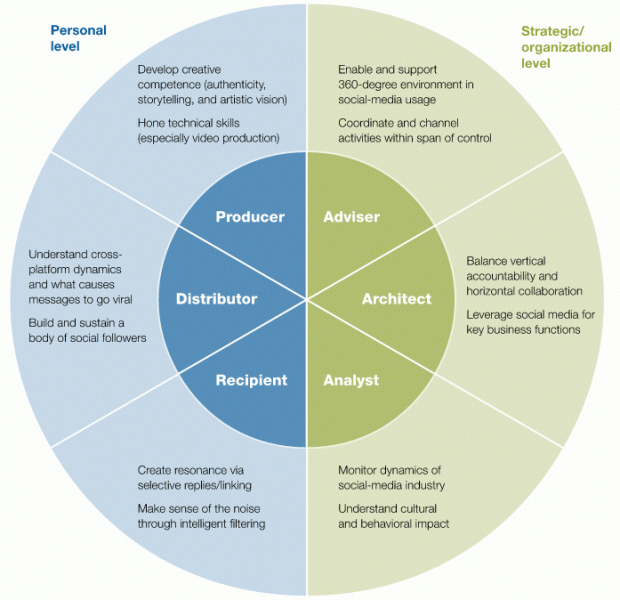While giving away control is seen as a flaw in a traditional context, this is the one and only true skill that should be addressed in leaders.
I should have known better when I picked up McKinsey Quarterly’s 2013 article on social media literacy, because I already knew that they are the laggards of all laggards when it comes to embracing innovation in management. Still I was curious to find out what the social media revolution means to them AND I was pleasantly appealed by the graphic that was included.
The graphic, by the way, still makes sense… but the vantage point from which is it presented is so poor and so traditional that I am back to the point where I started: a statement of the obvious fact that McKinsey is the strategic analysis dinosour of the stone age.

Source: http://www.mckinsey.com/insights/high_tech_telecoms_internet/six_social-media_skills_every_leader_needs
What we see in this article is a very restricted view on the use of social media; i.e.:one that is focussed on the features and consequences of putting into practice a new broadcasting tool. For the largest part, the article zooms in on how this new broadcasting tool will change the way “leaders” communicate with their organization (and I deliberately put the term between quotation marks, because the term is ill-defined). The emphasis is on the “tool” and the practical consequences of using it.
Sure, the authors do pick up the language of a ‘new literacy’, ‘co-creation’, ‘collaboration’, but the examples that are stated are restricted to traditional communication through new media. And this is probably the current reality at GE.
Don’t get me wrong, I work with traditional top-down hierarchical organizations day-to-day, so I know that what the people of GE achieved there deserves a corporate communication award – and I truly mean that. They are achieving what 90% of traditional hierarchical organizations are incapable of: a sound top-down corporate communication that speaks a human language. Believe me, in those contexts that is a revolution in itself.
But the authors of this article should know better than to pick up this “old wine in new bottles” and to advertise it as a prodigy of what social media is capable of. This is so below standards of what we should expect from a strategic consultancy. In social media speak: this is a fail.
And a fail becomes a crime when authors start extrapolating this reality to draw conclusions about leadership. What they present is a skill-set that is zeroing in on what a leader “must do” in order to keep control and to stay on top of this game. That’s right: placing yet another burden on the shoulders of these busy people. This is about the poorest and most shallow use of social media one can think of: yet another tool to exert control. At that point I want to cry.
In reality the potential of social media lies in the first part of the term: the ‘social’. NYU professor Clay Shirky summarizes this point succinctly when he states that:
Social media is the best tool for group communication since the table.
Social media unveils the structure of belonging. It has the potential to link people to what is going on. AND THAT DOES NOT GET MEASURED IN NUMBER OF UPLOADED VIDEOS FEATURING YOU. Really; I am weeping here. And my sadness turns into anger when I see that readers are tricked into very expensive mumbo-jumbo sentences such as this:
“Within this 360-degree span, executives should become trusted advisers, enabling and supporting their environment in the use of social tools, while ensuring that a culture of learning and reflection takes hold.”
Or this:
“When organizations and their leaders embrace the call to social-media literacy, they will initiate a positive loop allowing them to capitalize on the opportunities and disruptions that come with the new connectivity of a networked society.”
Wow, really?… can you give an example of that?
“90% of what we call management,” Peter Drucker said, “consists of making it difficult for people to get things done.” Well, the same is true for 90% of the advice that is given to leaders throughout this article. “But if not this, then what?” you might ask… Which is a fair question…
But then again, this article is a good thing because it shows us black-on-white that leadership in a top-down hierarchy has nothing to “do” in order to bring about the benefits of social media.
If we want to unlock the potential of the communities that reside within the context of an organization, we should in the first place look for ambassadors that emerge once we start to connect with people. It is only after building relationships with these ambassadors and giving away control to them and their communities that good things can happen such as product innovation, customer engagement and increased accountability for quality.
While giving away control is seen as a flaw in a traditional context, this is the one and only true skill that should be addressed in leaders. The only thing you can do as a leader is granting permission and then hope – vulnerable, with your arms and hands open towards the sky – that the community will find your gesture authentic enough to grant you the trust of their most valuable and intrinsic part of what drives them: their sense of belonging.
But before we get there we clearly need to address another problem: the need to let go of control and to trust our organizations. Thank you McKinsey for making this point so painstakingly clear. Therefore I close this rant with a quote from Gary Hamel:
The Bottleneck Is at the Top of the Bottle […] Where are you likely to find people with the least diversity of experience, the largest investment in the past, and the greatest reverence for industry dogma: At the top!



